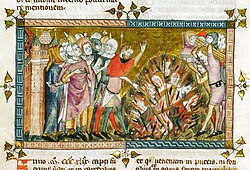History of implementation
| | This section needs expansion. You can help by expanding it. (June 2008) |
Instances of medieval usage
Well poisoning has been used as an important scorched earth tactic at least since medieval times. In 1462, for example, Prince Vlad III the Impaler of Wallachia utilized this method to delay his pursuing adversaries. Nearly 500 years later during the Winter War, the Finns rendered wells unusable by putting animal carcasses or feces in them in order to passively combat invading Soviet forces. [1]
Instances of modern usage
During the 20th century, the practice of poisoning wells has lost most of its potency and practicality against an organized force as modern military logistics ensure secure and decontaminated supplies and resources. Nevertheless, German forces during World War I poisoned wells in France as part of Operation Alberich. [2]
After World War II, Nakam, a paramilitary organisation of about fifty Holocaust survivors, sought revenge for the murder of six million Jews during the Holocaust. The group's leader Abba Kovner went to Mandatory Palestine in order to secure large quantities of poison[ clarification needed ] for poisoning water mains to kill large numbers of Germans. His followers infiltrated the water system of Nuremberg. However, Kovner was arrested upon arrival in the British zone of occupied Germany and had to throw the poison overboard. [3]
Israel poisoned the wells and water supplies of certain Palestinian towns and villages as part of their biological warfare program during the 1948 Palestine war, including an operation that caused a typhoid epidemic in Acre in early May 1948, and an unsuccessful attempt in Gaza that was foiled by the Egyptians in late May. [4]
In the late 20th century, accusations of well-poisoning were brought up, most notoriously in relation to the Kosovo War. [5] [6] [7] In the 21st century, Israeli settlers have been condemned due to suspicions of poisoning wells of villages in the occupied Palestine. [8] [9] [10]

